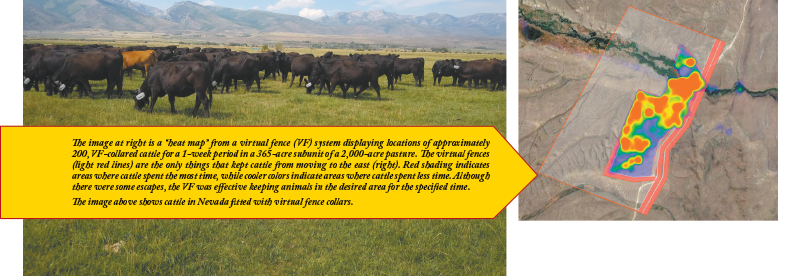 Sometimes, after speaking to a group about virtual fencing or working on some aspect of our project, I cannot help but think about some of the reasons why it strikes me as ironic that I am working with this cutting-edge technology. But it does not take long for me to convince myself (again) that I am an ideal person to be doing this work. I’ll come back to that after a brief introduction to virtual fencing.
Sometimes, after speaking to a group about virtual fencing or working on some aspect of our project, I cannot help but think about some of the reasons why it strikes me as ironic that I am working with this cutting-edge technology. But it does not take long for me to convince myself (again) that I am an ideal person to be doing this work. I’ll come back to that after a brief introduction to virtual fencing.
Virtual fencing for livestock is similar to the fenceless dog fences or invisible dog fences in that these systems use collars to deliver audio, and electrical stimulus cues to keep animals where you want them. Soon after being introduced to these systems, the animals will likely learn the association between the audio cue and the electrical stimulus so that they respond to the audio cue and avoid the electrical stimulus. Virtual fence systems for livestock use collars with GPS (global positioning system) capabilities to track animal locations relative to boundaries that the user establishes, and a computer software package that allows the user to “build fence”. Building virtual fence is essentially a point-and-click computer exercise to create polygons on a map, and then adding start times and stop times for that fence. You can do this on the hottest day in August without breaking a sweat or tearing your jeans on a barb!
Multiple virtual fences can be created and sent to the collars as the livestock manager moves animals across the landscape. Also, it is possible to use virtual fences for both inclusion and exclusion of livestock.
For a few reasons, I’m the last guy one might think of when it comes to cutting-edge technology. I’m that guy who walks into the copy room and sends the copier into extreme panic mode without even touching the machine! I cringe each and every time my computer or phone “updates” because I know it will take weeks or months to figure out how to do most of the things I had just re-learned to do since the last update! I truly miss my good ol’ flip-phone, and those of you who still use one are A-OK in my book! At the same time, and in some very important ways, I am the perfect person to be working on virtual fencing.
Soon after I started studying Range Management, I became committed to sustaining rangeland ecosystems as working landscapes that support the plants and animals (including, but not limited to wildlife, livestock and humans) that live there and the ecosystem processes that occur. For much of the past 25 years I have worked with livestock producers, federal and state agency natural resource managers and variety of other stakeholders to address challenges related to livestock grazing management on rangelands.
Through the years, and across a wide variety of situations involving livestock grazing management, solutions for maintaining already good conditions on the land, or bringing about needed improvement, involved efforts to manage the distribution of livestock use across large, expansive landscapes. Managing livestock distribution (and their use of the plants) across the landscape and through time empowers the manager to influence season of use, duration of use and intensity of use – the 3 fundamental components of grazing management. Often, the more options a manager has for moving animals around the landscape, the greater their management flexibility and likelihood of success. Fortunately, there are many great tools available to help manage animal distribution (including, but not limited to herding and stockmanship, attractants [water, supplement, mineral, etc.], conventional fencing).
I am optimistic about virtual fencing being another valuable tool to add to this toolbox. For these reasons, I am the perfect person to be working on virtual fencing. I share these reflections, because I expect that there might be some folks reading this who, like me, do not consider themselves particularly technologically savvy (say that fast, 4 times!), and might not think any further about virtual fencing. But, I bet many or most folks in that category are committed to managing livestock grazing on rangelands to meet both natural resource and production objectives, so actually might be ideal candidates to consider virtual fencing as a potential tool. As with the other tools in the grazing management toolbox, virtual fencing should be viewed as one to be considered by the livestock manager in terms of how it might fit their operation, their animals, their landscape and their management philosophy.
There is a lot of wisdom in the following statement that is often spoken by folks in range management about grazing systems. No grazing system will succeed everywhere, and every grazing system will fail somewhere. I think this also applies to various tools available for use in livestock grazing management. They need to fit the operation, the animals, the landscape and the humans involved. My hope is simply that this article will prompt some folks to think about virtual fencing as a potential tool for livestock grazing management.
Ultimately, the decision about whether or not virtual fencing should end up as one of the tools in a particular livestock manager’s toolbox should be up to that livestock manager.
by Paul Meiman | Extension Specialist – Rangeland Livestock/Wildlife Interactions
Associate Professor, Dept. of Ag., Veterinary and Rangeland Sciences | UNR Ext
775-738-7291| pmeiman@unr.edu | unce.unr.edu

